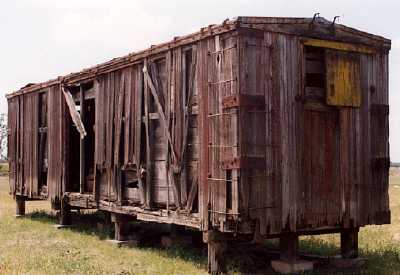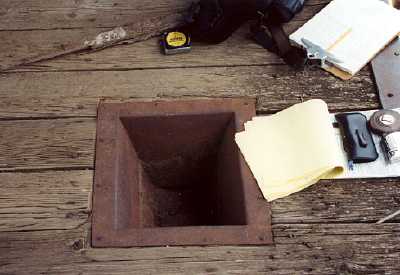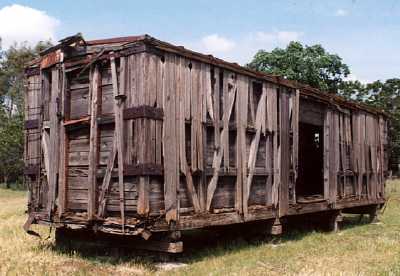A NORTHERN ELECTRIC MYSTERY:
THE HICKS ROAD BOXCARS
The Northern Electric Railway bought the bulk of its freight car fleet in 1907 and 1908. After over 90 years, the chance of finding any of these cars still in existence outside a museum might seem very slim. Surprisingly, in 2001 three of NE's original boxcars surfaced near Chico.
The three cars were located on a farm just off Hicks Road, not far from the old NE-SN Mulberry Shops. The three cars were in a line, standing on short legs. They had seen years of use as farm sheds. All three were in very poor condition, and the middle car had collapsed after a fire.

Allen Wood photographed and measured the three boxcars early in 2001, making two visits. At first he was in doubt that they were NE cars, but on his second visit he noticed traces of the NE's Maltese Cross herald, with part of the word "electric" still readable. No other lettering remained, except for some pencil scribbles and load marks inside which shed no further light on the cars' identities. Allen took careful measurements of certain key dimensions in the hope of matching them against known dimensions in the OFFICIAL RAILWAY EQUIPMENT REGISTER. However, what he discovered raised more questions than answers.

The NE and SN owned several groups of nearly identical wooden boxcars with a 36-foot inside length. From ORER entries and a few rare photos, they all appear to have been pretty much the same externally. The first group of NE boxcars were 2000-2049, purchased in 1907 from Fitzhugh-Luther Company. They featured an 8-foot inside height, and a 5-foot, 6-inch door opening. A photo of NE 2000 may be seen on page 196 of Swett's SACRAMENTO NORTHERN. The second group of cars were built by American Car & Foundry in 1908 and numbered 2050-2099. Their inside height was only 7 feet, 9 inches, but their door openings were 6 feet wide. The Sacramento Northern Railroad also built several similar cars in 1919, numbered 2101-2106. These had an 8-foot inside height, and 6-foot door openings. Finally, Pacific Car & Foundry delivered 2107-2128 in 1920 with the same dimensions.

Thus there are several key dimensions that in combination made three of the four groups of NE boxcars cars unique. It should have been possible to match the cars to ORER entries and determine their origin with some accuracy. Unfortunately, Allen's careful measurements suggest that this logic will not hold. One car had an odd 5-foot, 7-inch door opening, and the other two a more comfortable 5 feet, 6 inches. Despite the difference (which might have been from repair work) the door width suggests these were Fitzhugh-Luther cars. One car had an 8-foot inside height, but another measured only 7 feet, 10 inches, a non-standard dimension but close to the AC&F cars. Again this could be from rebuilding. The inside height could not be measured on the collapsed car. Finally, the Fitzhugh-Luther car in Swett's book shows two upright braces on the ends, upon which the lumber door was mounted. None of the three Hicks Road cars had these uprights, and their lumber doors were mounted directly on the end sheathing and interior framing. This arrangement is similar to an unpublished photo by Kenneth C. Jenkins of 2288, an AC&F car rebuilt in 1923.

Even more vexing, were the roof hatches and floor gates on two of the cars. These were apparently intended for grain loading, and fill lines with the names of various grains can still be seen inside one car. There is no mention of hatches or gates for any NE or SN boxcar in the ORER entries so far examined, and no such equipment mentioned in the 1916 California Public Utilities valuation, or in the 1928 Interstate Commerce Commission valuation. Nor is there any indication that the original NE cars had any major rebuilding, save for one Fitzhugh-Luther car (2249), and a small group of AC&F cars (2280-2288). These were extensively rebuilt and renumbered in 1923. Some of this group might have received roof hatches and gates at this time (2288 did not have them in the Jenkins photo).

According to Allen, the caretaker said the cars had been there as long as he had worked on the farm, at least since the 1950s. Most of the original NE boxcars were retired in 1934, so it is possible that they have been on the farm almost 70 years. If they are from the 1923 rebuilds, they must have been there since shortly after 1947 when that group was retired.
And so we are left with a tangle of mysteries (not unusual in SN's history). When were these cars retired? Why don't the dimensions match the ORER? When were the roof hatches and gates added, and why was this never mentioned in the ORER? Were these 1923 rebuilds, or were they cars from an original series?
Sadly, the cars were all destroyed to make room for a subdivision prior to 2008. Some interest had been shown by members of one of the area's railroad museums, but their experts thought the cars are too fragile to be moved. Allen's documentation and photos are the only reminder of their long lives.


